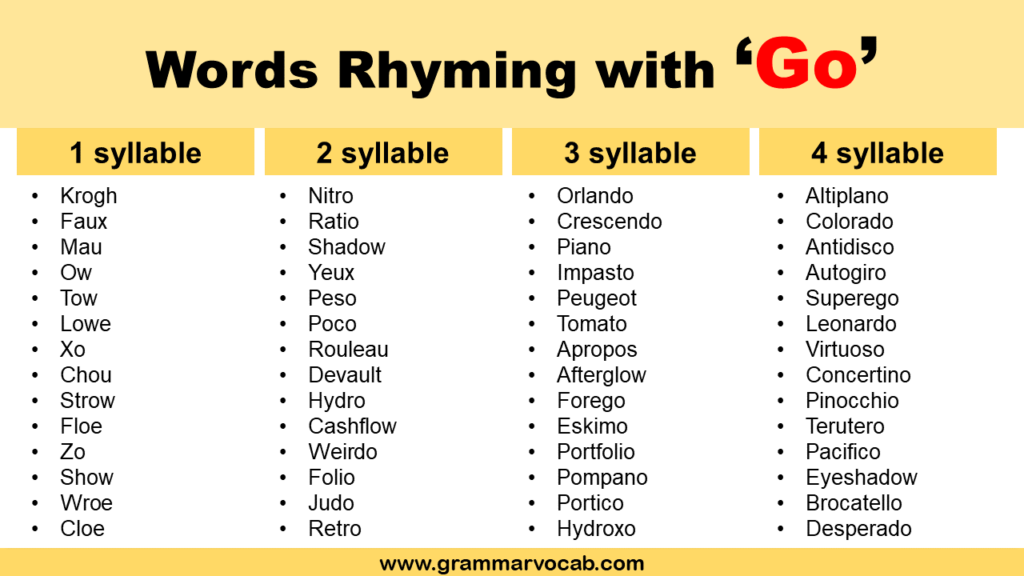Exploring Words That Rhyme with “Go”
Rhyming is an essential aspect of language that enhances poetry, music, and creative writing. Words that rhyme share similar sounds, particularly at the end of the word. This article delves into the various words that rhyme with “go,” their meanings, and how they can be used in different contexts. Additionally, we will explore the importance of rhyming in language and provide a comprehensive table of rhyming words.
The Importance of Rhyming
Rhyming plays a crucial role in language for several reasons:
- Enhances Memory: Rhymes make phrases easier to remember, which is why they are often used in songs, nursery rhymes, and poetry.
- Creates Rhythm: Rhyming contributes to the musicality of language, creating a rhythm that can enhance the emotional impact of the words.
- Encourages Creativity: Finding rhymes can inspire creativity, prompting writers to think outside the box and explore new ideas.
- Facilitates Learning: Rhyming helps children learn language and develop phonemic awareness, which is essential for reading and writing.
Words That Rhyme with “Go”
Here is a comprehensive list of words that rhyme with “go,” categorized by the number of syllables:
One-Syllable Rhymes
- Blow: To push air out forcefully.
- Crow: A type of bird known for its black feathers and distinctive cawing sound.
- Flow: To move smoothly and continuously.
- Glow: To emit light or brightness.
- Know: To have knowledge or awareness.
- Row: A line of things or people.
- Show: To display or present something.
- Throw: To propel something with force through the air.
- Toe: A digit on the foot.
- Foe: An enemy or opponent.
Two-Syllable Rhymes
- Below: At a lower level or position.
- Although: In spite of the fact that; even though.
- Mellow: Soft, rich, and well-aged; relaxed.
- Bamboo: A type of grass that is tall and woody.
- Tornado: A rapidly rotating column of air that is in contact with both the surface of the Earth and a cumulonimbus cloud.
Three-Syllable Rhymes
- Buffalo: A large animal known for its strength and size.
- Overthrow: To remove forcibly from power.
- Cameo: A brief appearance or role played by a well-known person in a work of the arts.
Table of Rhyming Words
| Number of Syllables | Rhyming Words |
|---|---|
| One | Blow, Crow, Flow, Glow, Know, Row, Show, Throw, Toe, Foe |
| Two | Below, Although, Mellow, Bamboo, Tornado |
| Three | Buffalo, Overthrow, Cameo |
Creative Uses of Rhyming Words
Rhyming words can be effectively used in various forms of writing, including poetry, song lyrics, and storytelling. Here are some examples of how to incorporate rhymes into creative works:
Example 1: Poetry
In a poem, rhymes can create a lyrical quality:The wind does blow, as the rivers flow,
In the garden where the flowers grow.
With every crow, I learn to know,
The beauty of nature, a wondrous show.
Example 2: Song Lyrics
In songwriting, rhymes add to the catchiness of the song:Let’s go, let’s throw, under the moon’s glow,
Dancing in the night, moving slow.
With every beat, our hearts will know,
Together we’ll shine, like stars in a row.
Frequently Asked Questions (FAQ)
Q1: What are some common uses for rhyming words?A1: Rhyming words are commonly used in poetry, song lyrics, nursery rhymes, and advertising slogans to create memorable and engaging content.
Q2: How can I improve my rhyming skills?A2: You can improve your rhyming skills by reading poetry, writing your own verses, and using rhyming dictionaries or apps to find suitable rhymes.
Q3: Are there different types of rhymes?A3: Yes, there are several types of rhymes, including perfect rhymes (exact sound matches), near rhymes (similar but not identical sounds), and internal rhymes (rhymes within a single line of verse).
Q4: What is the significance of rhyming in children’s literature?A4: Rhyming in children’s literature helps with phonemic awareness, making it easier for children to learn to read and write while also engaging them through rhythm and sound.
Q5: Can you provide a link for more information on rhyming?A5: For more detailed information on rhyming and its applications, you can refer to the Wikipedia page on Rhyme.
Conclusion
Rhyming is a fundamental aspect of language that enhances creativity, memory, and engagement. With a rich variety of words that rhyme with “go,” writers and poets can explore endless possibilities for expression. Whether in poetry, songs, or storytelling, the use of rhymes adds beauty and rhythm to language, making it an essential tool for effective communication.
Read more about it:https://greyhoundsverdevalley.com/how-to-change-fire-alarm-battery/



